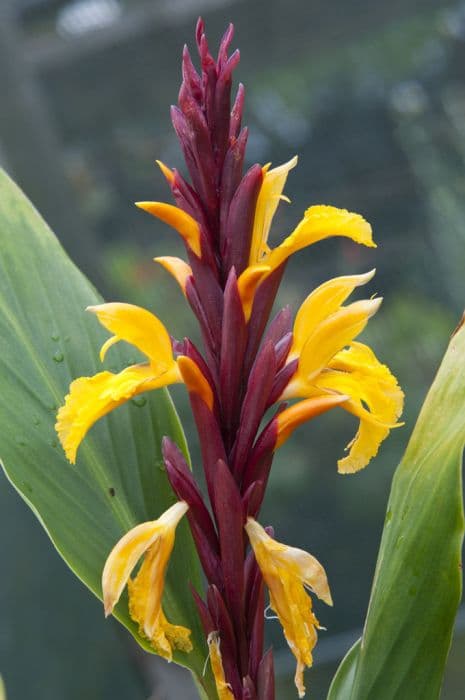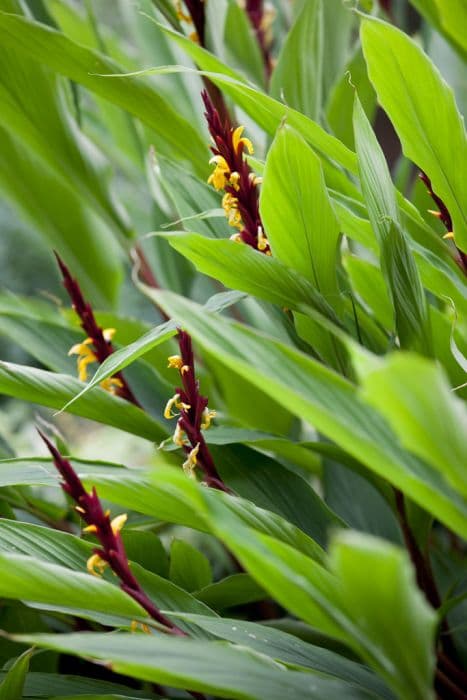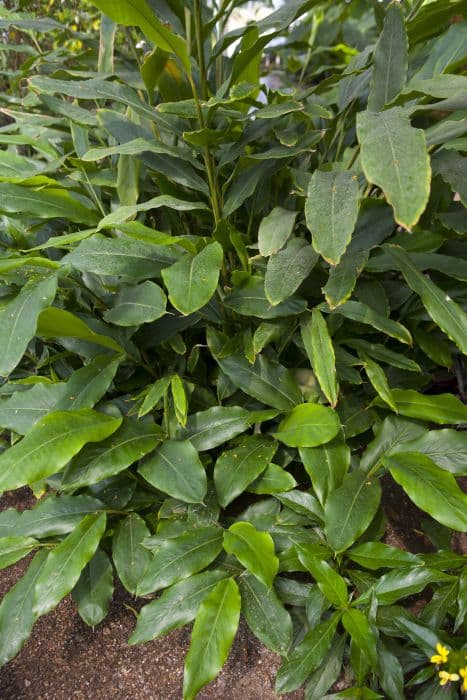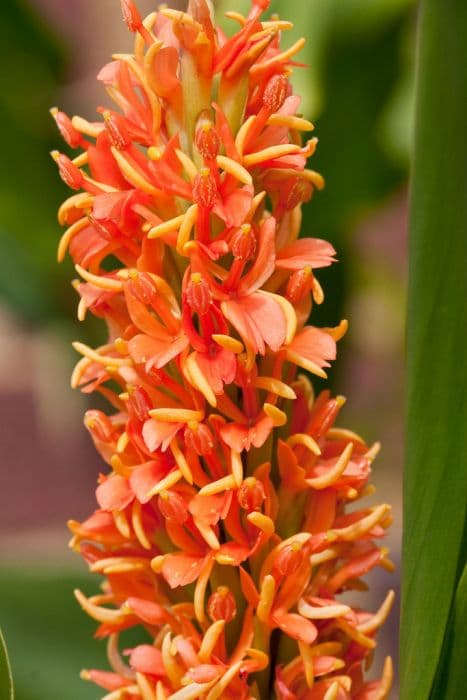Black Lily Ginger Roscoea scillifolia f. atropurpurea

ABOUT
This plant is a floral species known for its distinctive and appealing features. It's characterized by striking leaves that create a lush green backdrop for the prominent flowers it bears. The flowers are particularly exquisite and possess a rich, deep purple color that can vary in intensity but generally presents a striking hue that can add a dramatic flair to any garden setting. The leaves are typically long and narrow, with a smooth texture that can vary in shades of green, often providing a stark contrast to the intense color of the flowers. The blooming period of this plant brings forth a display that attracts garden enthusiasts and pollinators alike.
About this plant
 Names
NamesFamily
Zingiberaceae
Synonyms
Purple Roscoea, Dark-Flowered Roscoea, Atropurpurea Roscoea
Common names
Roscoea scillifolia f. atropurpurea.
 Toxicity
ToxicityTo humans
Roscoea does not typically have a reputation as a toxic plant, and there is no widely acknowledged information suggesting that Roscoea scillifolia f. atropurpurea, commonly known as Roscoea, is poisonous to humans. There appears to be little to no evidence in the scientific literature regarding any toxicity related to this particular plant to humans. However, as a general precaution with any plant, it's recommended to avoid ingestion unless it is known to be edible and safe. Accidental ingestion of unknown plants could potentially pose risks due to individual allergies or specific plant compounds.
To pets
Similar to its effects on humans, there is no significant evidence to suggest that Roscoea scillifolia f. atropurpurea, commonly known as Roscoea, is toxic to pets. The plant is not commonly listed among those that pose a risk of poisoning to household pets like dogs and cats. Nevertheless, it is always prudent to prevent pets from eating plants that are not confirmed to be safe, as individual animals might have unique sensitivities, or there could be unknown risks not well documented in the available literature. If a pet does ingest this plant and shows signs of distress or illness, contacting a veterinarian is advised.
 Characteristics
CharacteristicsLife cycle
Perennials
Foliage type
Deciduous
Color of leaves
Green
Flower color
Purple
Height
1 foot (0.3 meters)
Spread
1 foot (0.3 meters)
Plant type
Herb
Hardiness zones
6
Native area
China
Benefits
 General Benefits
General Benefits- Ornamental Value: This variety of Roscoea, commonly known as Purple Roscoea, adds aesthetic value to gardens with its attractive purple flowers.
- Low Maintenance: Purple Roscoea is generally easy to care for and requires minimal maintenance once established.
- Cold Hardy: It is relatively cold hardy and can survive in cooler climates, which is unusual for a member of the ginger family.
- Attracts Pollinators: The vibrant flowers attract bees and other pollinators, which are beneficial for the garden ecosystem.
- Drought Tolerance: Purple Roscoea has some level of drought tolerance, making it suitable for gardens in drier climates.
- Shade Tolerance: This plant can thrive in partial shade, providing flexibility in garden design for areas with less direct sunlight.
 Medical Properties
Medical PropertiesThis plant is not used for medical purposes.
 Air-purifying Qualities
Air-purifying QualitiesThis plant is not specifically known for air purifying qualities.
 Other Uses
Other Uses- Roscoea scillifolia f. atropurpurea, commonly known as Purple Roscoea, can be used for educational purposes in botany and horticulture to teach about plant adaptation and evolution in mountainous environments.
- In garden design, Purple Roscoea's striking flowers can be utilized to create high-impact visual contrast in rock gardens and alpine garden settings.
- The plant can serve as a food source for pollinators such as bees and butterflies, playing a role in supporting local ecosystems.
- Purple Roscoea may be featured in botanical art and photography due to its unique and vibrant the flowers making it an attractive subject.
- The plant can be used in eco-friendly landscaping as it may require fewer pesticides and herbicides compared to non-native species.
- Purple Roscoea can be grown as part of conservation efforts to preserve rare and endangered plant species.
- The fibrous roots of the plant could be studied for their soil stabilization properties, particularly on sloped terrain in gardens or restoration projects.
- The leaves of Purple Roscoea can be used in floral arrangements as a green backdrop to complement more colorful blooms.
- Due to its unique appearance, the plant may be cultivated for use in themed gardens, such as those which focus on Himalayan flora.
- Some communities might use dried and pressed specimens of Purple Roscoea in traditional herbarium collections for cultural or historical purposes.
Interesting Facts
 Feng Shui
Feng ShuiThe plant Roscoea is not used in Feng Shui practice.
 Zodiac Sign Compitability
Zodiac Sign CompitabilityThe plant Roscoea is not used in astrology practice.
 Plant Symbolism
Plant Symbolism- Rarity: Roscoea scillifolia f. atropurpurea, commonly referred to as the Roscoea, is not a widely known plant, thus its symbolism often relates to the unique, rare, or hard-to-find characteristics in life.
- Exotic Beauty: The Roscoea's striking appearance, with its purple-hued flowers, can symbolize exotic beauty and the appreciation of unique aesthetic qualities.
- Adaptability: As the Roscoea can thrive in various conditions, it symbolizes adaptability and the ability to prosper in different environments.
- Mystery: The plant's lesser-known status and distinct look may represent the enigmatic or mysterious aspects of nature.
 Water
WaterFor the plant commonly known as Roscoea, it's important to water it thoroughly whenever the top inch of soil feels dry to the touch. On average, this might be approximately once a week, but the frequency can vary with climate and indoor conditions. It's best to add water slowly until it begins to drain from the bottom of the pot, which could mean using roughly 16-32 ounces for a medium-sized pot. Avoid letting the plant sit in standing water as this can lead to root rot. During the dormant season in winter, reduce watering frequency as the plant's water requirements decrease.
 Light
LightThe ideal light condition for Roscoea is bright, indirect sunlight. It thrives best when placed in a location that receives several hours of morning sun and then dappled or partial shade in the afternoon. Avoid direct, strong sunlight during the peak hours as it can cause the leaves to burn.
 Temperature
TemperatureRoscoeas are hardy and prefer cooler temperature conditions. They can survive in temperatures as low as 32°F but thrive best between 50°F and 75°F. Ensure that the plants are protected from extreme temperatures above 85°F to prevent heat stress.
 Pruning
PruningPruning Roscoea is mainly done to remove any spent flowers and dead foliage to encourage new growth and maintain an attractive appearance. The best time to prune is after the flowering season ends. Pruning is typically done annually or as needed to shape the plant or remove damaged parts.
 Cleaning
CleaningAs needed
 Soil
SoilRoscoea, commonly known as Purple Roscoea, thrives best in a soil mix that is well-draining and rich in organic matter. The ideal soil mixture for Purple Roscoea should consist of a blend of loam, leaf mold, perlite, and compost, providing good aeration and moisture retention. The plant prefers a soil pH ranging from slightly acidic to neutral, around 6.0 to 7.0.
 Repotting
RepottingPurple Roscoea should be repotted every 2-3 years to replenish the soil and to accommodate its growing roots. It is best to repot the plant in spring before the new growth starts.
 Humidity & Misting
Humidity & MistingPurple Roscoea prefers moderate humidity levels, ideal around 50-60%. While they can tolerate some fluctuation, consistent humidity is beneficial for their growth.
 Suitable locations
Suitable locationsIndoor
Provide indirect light, well-draining soil, and keep it at 50-60% humidity.
Outdoor
Plant in partial shade, ensure well-draining soil, and protect from harsh sun.
Hardiness zone
7-9 USDA
 Life cycle
Life cycleRoscoea scillifolia f. atropurpurea, commonly known as Purple Roscoea, begins its life cycle when seeds are sown in the soil, typically requiring a period of cold stratification to germinate. Upon germination, seedlings emerge and develop into juvenile plants with characteristic lance-shaped leaves. As the plants mature, they form a pseudostem and foliage typical of the Roscoea genus. In the flowering stage, Purple Roscoea produces distinctive purple flowers in the late spring or early summer, which are pollinated by insects, leading to seed formation. After flowering, as autumn approaches, the aerial parts of the plant die back and the plant enters a period of dormancy, with the underground rhizome surviving through the winter. With the onset of the next growing season, the cycle repeats as new shoots emerge from the rhizome.
 Propogation
PropogationPropogation time
Spring
Roscoea scillifolia f. atropurpurea, commonly known as Purple Roscoea, is typically propagated by dividing its rhizomes. The ideal time for this method is in the spring, just as new growth begins to appear. To propagate Purple Roscoea, carefully lift the plant from the soil and gently separate the rhizomes, ensuring that each division has at least one growth bud. These divisions can then be replanted into well-draining soil at a depth of about 2 inches (5 centimeters), spaced roughly 6 to 8 inches (15 to 20 centimeters) apart. Water the divisions well after planting to help establish them. With proper care, these new plants will grow and can eventually be divided themselves, perpetuating the propagation cycle.









